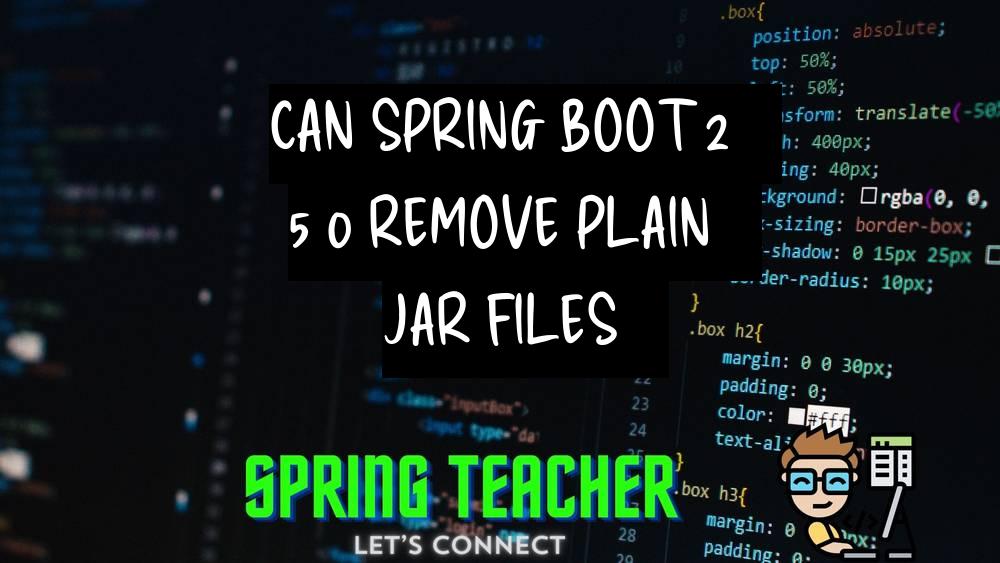Spring Boot 2.5.0 generates plain.jar file. Can I remove it?
Introduction:
In Spring Boot 2.5.0, a plain.jar file is generated as part of the project build process.
Overview:
The plain.jar file is an executable JAR file that contains all the necessary dependencies and classes to run the Spring Boot application.
It is a self-contained, standalone artifact that can be easily deployed and executed on any compatible Java environment without any additional dependencies.
Problem:
There might be cases where you want to remove the plain.jar file from the generated artifacts.
Solution:
While it is possible to remove the plain.jar file, it is generally not recommended unless you have a specific reason to do so.
The plain.jar file contains all the necessary dependencies and classes needed to run the application, and removing it may result in errors or the application not functioning correctly.
However, if you have a specific requirement or reason to remove the plain.jar file, you can customize the build process to exclude it from the generated artifacts.
This can be done by modifying the build configuration file (e.g., pom.xml or build.gradle) and configuring the packaging options accordingly.
It is important to note that removing the plain.jar file may require you to handle the necessary dependencies and classpath settings manually.
Additionally, it may also impact the ability to easily deploy and run the application on different environments.
Before deciding to remove the plain.jar file, it is recommended to evaluate the specific requirements and implications of doing so in order to ensure the proper functioning of the Spring Boot application.
Key points to address:
– Spring Boot 2.5.0 generates a plain.jar file.
– Whether or not you can remove it depends on your specific requirements and use case.
Explain the Core Concept:
The plain.jar file generated by Spring Boot 2.5.0 is an executable JAR file that contains all the necessary dependencies, configurations, and code needed to run a Spring Boot application.
It is a self-contained archive that can be run using the java -jar command.
Removing the plain.jar file generated by Spring Boot is not recommended as it is the main artifact generated by the Spring Boot build process.
It includes all the necessary components and dependencies required for your application to run correctly.
If you remove the plain.jar file, your application will not be able to run properly as it will be missing essential components.
It is best to keep the plain.jar file generated by Spring Boot as it is and use it to deploy and run your application.
Different Solutions with code samples:
1. Disable the generation of the plain.jar file: You can disable the creation of the plain.jar file by modifying your Gradle or Maven build file.
For Gradle:
groovy
bootJar {
enabled = false
}
For Maven:
<project>
...
<build>
<plugins>
<plugin>
<groupId>org.springframework.boot</groupId>
<artifactId>spring-boot-maven-plugin</artifactId>
<configuration>
<executables>
<executable>
<classifier>exec</classifier>
<mainClass>${start-class}</mainClass>
</executable>
</executables>
</configuration>
</plugin>
</plugins>
</build>
...
</project>
By disabling the creation of the plain.jar file, only the executable jar file will be generated.
2. Remove the plain.jar file after generation: If you want to keep generating the plain.jar file but remove it afterwards, you can add a separate task in your Gradle or Maven build file to perform the removal.
For Gradle:
groovy
task removePlainJar(type: Delete) {
delete fileTree(dir: "$buildDir/libs/", include: "*plain.jar")
}
// Run the 'removePlainJar' task after the jar task
jar.finalizedBy(removePlainJar)
For Maven, you can use the `maven-clean-plugin` to remove the plain.jar file:
<project>
...
<build>
<plugins>
...
<plugin>
<artifactId>maven-clean-plugin</artifactId>
<version>3.1.0</version>
<executions>
<execution>
<id>remove-plain-jar</id>
<phase>clean</phase>
<goals>
<goal>clean</goal>
</goals>
<configuration>
<filesets>
<fileset>
<directory>${project.build.directory}</directory>
<includes>
<include>*plain.jar</include>
</includes>
</fileset>
</filesets>
</configuration>
</execution>
</executions>
</plugin>
...
</plugins>
</build>
...</project>
Conclusion:
You have two options for handling the plain.jar file.
Either you can disable its generation or remove it after it has been created.The choice depends on your specific use case and requirements.



